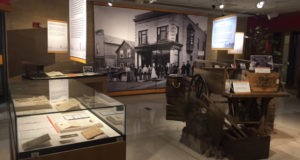“The collections we have seen get the most use have been related to Jewish communities in North Dakota,” said Kate Dietrick, the archivist at the Berman Archives. “A lot of the settlers in both Dakotas started their immigrant experience there and then moved to the Twin Cities. People are interested in their family history. It’s a different story than the people who came right to the Twin Cities.”
Dietrick said that one of the strengths of the exhibit that it tells a different story of the Jewish immigrant experience that many people don’t know.
“You think Lower-East Side tenaments, and this is not that,” Dietrick said.
Dietrick explained that the established Jewish community, made up of a lot of German immigrants, didn’t know how to support the eastern European immigrants that were coming. The raised money to send them to the Dakotas, which at the time, wasn’t without appeal.
“The Homestead Act of 1862, said you could get 160 acres for free if you lived on the land and improved it for 5 years,” Dietrick said. “As a Jew in Russia, you weren’t allowed to own land. To get the land for free was appealing.”
There were also large Jewish agricultural societies in New York and Chicago that would provide loans and capital to live their life on the prairie.
“That’s how you’d see families going to agricultural and homestead areas,” Dietrick said. “They are trying to work their land in the Dakotas. It wasn’t used for farming before. They get the land, sell it, and leave for the Twin Cities or for an area with a larger Jewish community.”
The exhibit also tackles Jewish entrepreneurs. Dietrick said that areas like mining, lumber, milling and banking had been closed off to Jews, so entrepreneurs set up businesses. The exhibit has artifacts from department stores in Duluth, butcher shop in Tower, and a grocery store in Virginia.
Dietrick said that where they worked with the Jewish Historical Society of the Upper Midwest is to have artifacts on display. Among the items, Dietrick said, is a Hebrew typewriter and Torah scrolls from Minot, ND.
“What we have is paper documents, photos and telegrams,” she said. “They are interesting when you read them but not visually dynamic.”

